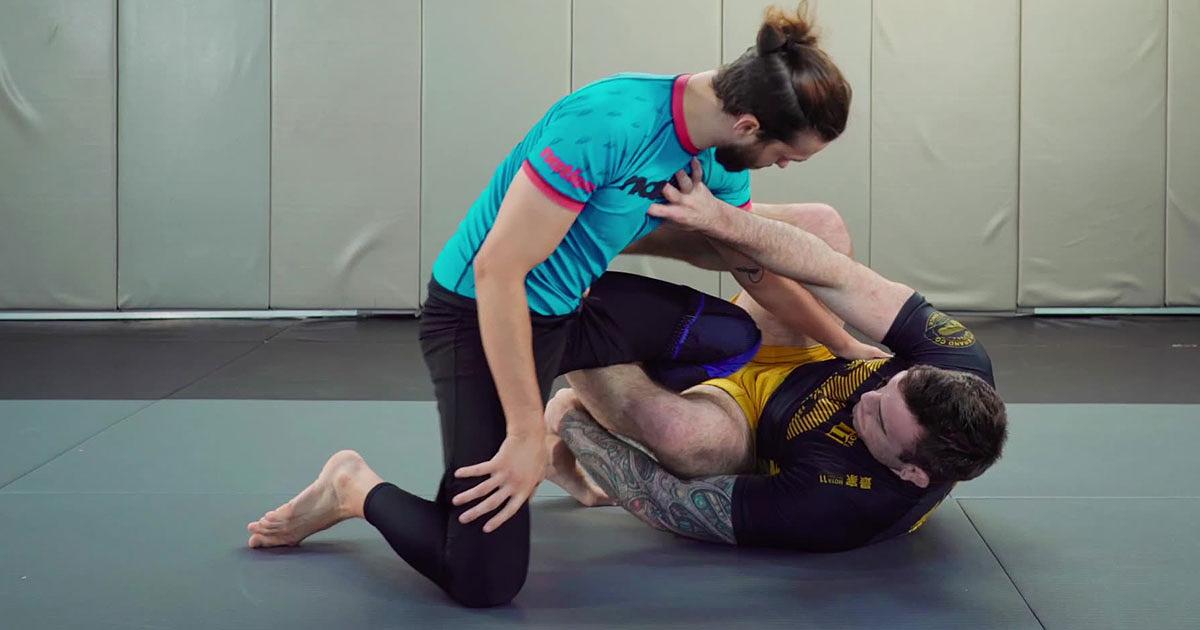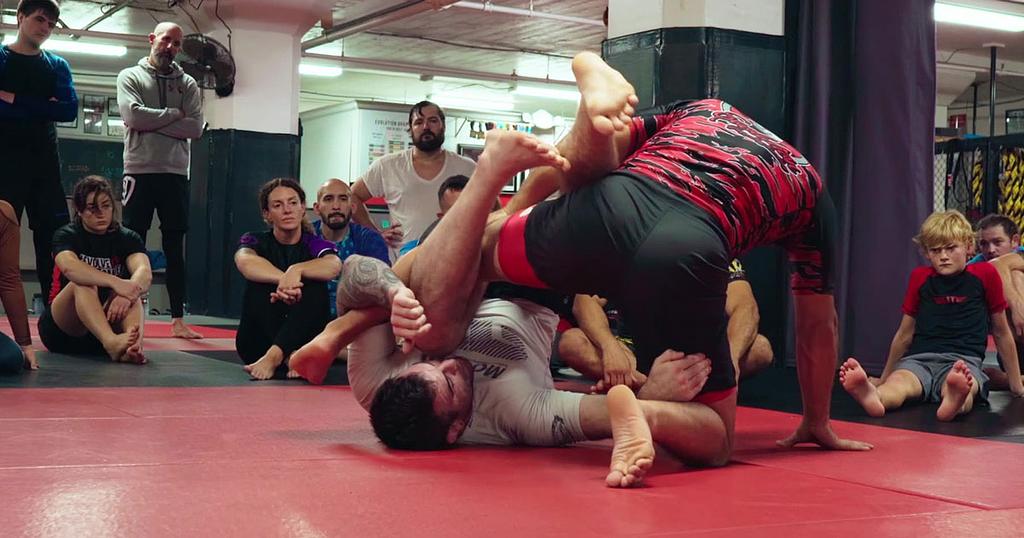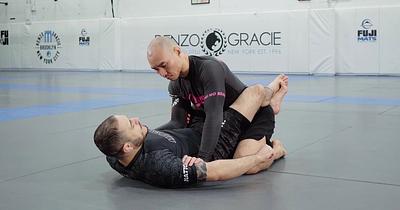Fundamentals of the Reverse De La Riva Guard
by Team Digitsu
Updated: April 16, 2024

In Brazilian Jiu-Jitsu (BJJ), mastering various guards is essential to your defensive game. The Reverse De La Riva guard stands out as an innovative position designed to counter aggressive passers, whether you're rolling in gi or no-gi. This guard variation offers you a dynamic way to control an opponent by using an inside leg hook, making it harder for them to maintain balance or advance their position.
The Reverse De La Riva, often seen as an evolved form of the traditional De La Riva guard, provides you with a foundation for a multitude of transitions and submissions. By effectively using the Reverse De La Riva, you place yourself in an advantageous spot to disrupt your opponent's base and create openings for attacks, all while maintaining a strong defensive structure.
As you integrate this guard into your BJJ repertoire, you’ll find that it not only enhances your bottom game but also opens up new pathways to advanced techniques. Whether you aim to sweep, submit, or transition to a more dominant position, the Reverse De La Riva guard is a versatile tool that will elevate your overall grappling strategy.
Understanding Reverse De La Riva Guard
The Reverse De La Riva Guard can enhance your defensive and offensive game by offering unique control and balance disruption methods.
Fundamentals and Core Concepts
Your exploration of the Reverse De La Riva Guard (RDLR) starts with grasping its fundamentals. This position is a derivative of the De La Riva hook, pivoting on a distinctive inside hook with your leg. This setup is crucial for managing distance and creating leverage as you position your hip against your opponent. Achieving control is elemental, with your hooked leg applying pressure against the opponent's thigh, which becomes the fulcrum for controlling their movement and setting up positions for attacks or sweeps.
Reverse De La Riva Hook Mechanics
Understanding the mechanics of the RDLR hook is pivotal. This hook acts as a barrier to retain distance and acts as a springboard for transitions. Your role in maintaining this hook is to ensure that your foot stays firmly connected to your opponent's hip or thigh, depending on the situation, while your other leg remains free to manipulate distance or off-balance your opponent. Your outside hand should grip the opponent's ankle or pant, exerting control and compromising their balance to execute your strategy effectively.
Executing Sweeps from Reverse De La Riva
The Reverse De La Riva guard offers dynamic sweeping options that emphasize leverage and timing. Let's break down the practical steps to ensure your sweeps are successful.
Basic Sweep Techniques
When executing basic sweep techniques from the Reverse De La Riva guard, your focus should be on disrupting your opponent's balance and securing control points.
- Control Their Lead Leg: Secure the leg that's closest to you, often with a grip behind the knee or ankle.
- Off-Balance Your Opponent: Use your Reverse De La Riva hook to elevate or push their controlled leg, compromising their stability.
- Execute the Sweep: When they're off-balance, transition smoothly to a favorable top position.
Remember, your timing is crucial. Sweep when your opponent is trying to advance or when they're adjusting their base.
Advanced Sweeps and Combinations
In advanced sweeps and combinations, integrating more complex transitions and techniques is key. The incorporation of movements like the berimbolo or kiss of the dragon enables you to catch your opponents by surprise.
-
Berimbolo:
- From a hooked position, invert underneath your opponent when they pressure forward.
- Spin to their back, using momentum to unbalance and sweep them.
- Kiss of the Dragon:
-

Mason Fowler inverts from Reverse De La Riva performing the Kiss of the Dragon sweep. - With your opponent standing, transition beneath them, targeting the back.
- Rotate your body inside their legs to sweep or transition to back control.
Both advanced techniques demand a thorough understanding of the underlying mechanics and frequent practice to enhance fluency and reaction time. Keep refining these sophisticated sweeps, solidifying your awareness and control during practice.
Mastering Submissions from Reverse De La Riva
In the Reverse De La Riva guard, your ability to transition into submissions can define the difference between a good practitioner and an exceptional one. This section focuses on the variety of submissions you can execute from this dynamic position and how to set them up effectively.
Submission Options
From the Reverse De La Riva guard, your submission options are extensive, allowing you to attack various joints effectively. Two of the highest percentage submissions from this position are the ankle lock and the omoplata. Here's a brief on how to execute these attacks:
-
Ankle Lock:
- Secure your grip around your opponent's near ankle.
- Fall to your side, creating an angle that puts pressure on the ankle.
-
Omoplata:
- Force your opponent's arm to the mat as you spin underneath.
- Sit up and over your opponent's back, securing their arm with your legs.
Each submission is a sequence of strategic movements that leverages your position to create vulnerability in your opponent's defense.
Reverse De La Riva Guard Passes
Mastering defenses against guard passes is essential when you're playing the Reverse De La Riva guard. You're about to learn preventative strategies and how to counter aggressive passing attempts, which will keep your guard game robust and challenging for opponents.
Preventative Measures Against Guard Passes
When playing the Reverse De La Riva guard (RDLR), it is crucial to be proactive to prevent guard passes. Your first line of defense is maintaining a strong grip on your opponent's sleeve or ankle. This control not only disrupts their balance but also hampers their ability to execute passes such as the knee slice pass or bullfighting pass.
- Grip Control: Always control the ankle or sleeve of the leg you're hooking.
- Hook Maintenance: Keep your RDLR hook active and engaged to prevent your opponent from stepping over or removing it.
Countering Aggressive Passing Opponents
Against an aggressive passing opponent, your timing and transitions need to be sharp. If an opponent attempts a knee slice pass, redirect their force by extending your RDLR hook and using the leverage to create space or transition to a different guard. For opponents who prefer the bullfighting pass or x pass, a swift transition to a sit-up guard or creating a frame against their leading arm can stifle their momentum.
- Knee Slice Defense: Use an active RDLR hook to disturb their base, and look for an underhook to prevent them from flattening you out.
- Bullfighting/X Pass Defense: Create a strong frame and combine it with a hip escape to retain your guard.
Defending and Escaping Reverse De La Riva Guard
In BJJ, effectively defending against and escaping the Reverse De La Riva Guard relies on proper posture, grip fighting, and tactical transitions. Recognizing the importance of guard recovery and the utilization of hooks will vastly improve your defensive skills.
Common Escapes
- Back Step Pass: Aim to control your opponent's leg that's hooking you. By creating pressure on their thigh and maintaining a firm posture, disengage the hook and execute a back step with your trapped leg. This positional transition requires quickness and balance to avoid counters.
- Knee Slice: To counteract your opponent's RDLR, first ensure a defensive posture with your hooks in to prevent them from gaining leverage. Grip their collar or sleeve, and use your free knee to slice through the guard and aim for a side control position.
- Leg Drag: Neutralize their hooks by grabbing the pant leg of the hooking leg and dragging it across your body. This escape can lead to a dominant passing opportunity, provided you maintain strong posture and keep your balance.
Recovering Guard and Retaining Control
- Retain Hooks: To recover from a compromised RDLR, ensure your hooks are active. Adjust them to disrupt your opponent's balance, making it more difficult for them to solidify their escape.
- Hip Escape/Shrimping: Utilize the hip escape movement to create space between you and your opponent. This allows you to swing your legs inside and reestablish your guard. Focus on transitions that prioritize repositioning your hips to retain your defensive posture.
Remember, successful escapes and guard recoveries are about being one step ahead of your opponent and manipulating their posture and balance to your advantage.
Reverse De La Riva Strategies and Concepts
In grappling, mastering the Reverse De La Riva Guard equips you with a potent offensive tool and the adaptability to handle various opponents. This guard opens up a myriad of attacking options through strategic positioning and transitions.
Offensive Strategies and Attack Sequences
To effectively employ the Reverse De La Riva Guard, your offensive strategies should center on control and mobility. Focus on maintaining a robust inside hook and using a combination of sleeve, collar, or ankle grips to off-balance your opponent. Utilizing these grips allows you to create leverage for sweeps and set up submissions. Here are some key points:
- Attacking options: Look to execute sweeps by compromising your opponent's base. The Reverse De La Riva Hook is instrumental in controlling their lead leg, which can help sweep them onto their back, yielding a pathway to superior positions.
- Sequences: Transition smoothly from the Reverse De La Riva Guard to other guards like the X-guard or to leg entanglements that open up submission opportunities.
Adapting to Different Opponent Types
Your approach to the Reverse De La Riva Guard must be adaptable to counter the variety in your opponents' strategies and physical attributes.
- Larger Opponents: When facing bigger opponents, emphasize maintaining distance with your hooks and grips. Use their size against them through swift transitions that exploit the natural openings in their defense.
- Aggressive Opponents: Against a highly offensive opponent, use the Reverse De La Riva to redirect their energy. Counter-attacks become your primary tool, waiting for the opportune moment to attack when they over-commit to their movements.
Notable Practitioners and Matches
When you explore the Reverse De La Riva Guard (RDLR), it's essential to recognize its most outstanding practitioners who have demonstrated the effectiveness of this position in high-level competition.
Caio Terra: Often attributed with the development of the RDLR, his technical mastery is renowned. His numerous matches showcase the practicality of RDLR in both defense and offense.
- Caio Terra Multiple-time world champion
- Lachlan Giles ADCC standout
- Dante Leon Known for dynamic Guard game
Lachlan Giles, an ADCC competitor known for his analytical approach, often uses the RDLR to outmaneuver opponents. His instructional on the position provides a comprehensive understanding.
Saulo Ribeiro, a legend in the sport, has been a part of the jiu-jitsu revolution, bringing heightened strategic plays into his matches, including the RDLR.
Dante Leon has been a rising star in the grappling world, where his use of the RDLR has been impressive, showcasing his adaptability against elite grapplers.
In action, the RDLR guard is a platform for a diverse arsenal of sweeps and submissions. Matches featuring these players are a testament to the guard's versatility—whether you're studying jiu-jitsu revolution through the lens of Saulo Ribeiro or seeking to emulate the modern dynamism of Dante Leon.
In your own practice, examining these practitioners can guide you to refine your RDLR techniques and strategic application.


